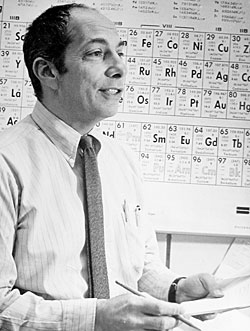Frederic Holtzberg
DOI: 10.1063/PT.3.1687
Materials scientist Frederic Holtzberg passed away in Greenport, New York, on 24 April 2012 after an extended illness. He was a distinguished member of the IBM Research Division, where he worked from 1952 through 1993. Although trained in chemistry, he had diverse interests that encompassed other disciplines, particularly physics. Holtzberg made outstanding contributions to our understanding of rare-earth materials, especially magnetic semiconductors and materials with strong electron correlations. He was the co-recipient, with Francis DiSalvo Jr, of the American Physical Society’s 1991 International Prize for New Materials for his discovery of new materials characterized by strong electron correlations.
Born in New York City on 12 April 1922, Holtzberg served in the US Army, including some time in India. He received his BS in chemistry at Brooklyn College in 1947, and under the guidance of crystallographer Isidor Fankuchen, in 1952 he completed his PhD on the structure of formic acid at the Polytechnic Institute of Brooklyn. That year he joined the IBM Thomas J. Watson Research Center at Columbia University. From 1959 to 1960 he took a leave of absence to become a technical assistant and consultant with the White House office of science and technology. He then rejoined the Watson Research Center, which had moved to Westchester County, New York.
Holtzberg’s career as a materials scientist spanned many of the important developments in rare-earth research. With interdisciplinary insight and talent, he performed new syntheses and fabricated novel materials that led to the exploration of new physical phenomena. His creation and study of new rare-earth materials were critical in developing several still-active fields of research, including magnetic semiconductors, intermediate valence, and high-temperature superconductors. He was aided in his efforts by his wide family of collaborators, which included solid-state physicists and chemists from the US, the UK, Germany, and France. Not only did Holtzberg create samples that made the experiments possible, but he also initiated ideas and directions for such experiments.
Following the 1961 discovery by Bernd Matthias and colleagues that europium oxide was a ferromagnetic insulator, Holtzberg and Siegfried Methfessel embarked on original studies on the Eu chalcogenides and their alloys. Holtzberg and Methfessel had the idea to produce magnetic semiconductors made from that class of materials. That led to their well-known 1964–66 work establishing the magnetic phase diagrams of solid, insulating Eu chalcogenide solutions with trivalent rare-earth metals. The importance of those studies cannot be overemphasized, since at that time all interest in Eu compounds focused on pure materials. Holtzberg showed that the entire series of solid solutions could be produced in single-crystal form, that adding the trivalent rare earths made the materials good conductors, and that the electrons modified the magnetic exchange. That insight influenced rare-earth research thereafter and swiftly led to major efforts at ETH Zürich, MIT, and IBM.
His expertise in rare-earth materials led Holtzberg naturally to the subject of intermediate valence. In 1970 Aiyasami Jayaraman at Bell Labs had discovered in samarium sulfide a pressure-induced insulator–metal transition, in which the color changed from black to gold and the lattice constant collapsed by 5% without a change in crystal structure. Holtzberg discovered in 1973 that he could induce the transition by “chemical pressure” in solid solutions of samarium sulfide with lanthanum and yttrium sulfide. Independently, Jayaraman reported on a similar study using gadolinium sulfide the same year.
In 1975 Holtzberg visited the low-temperature research center of CNRS in Grenoble, France, and started an effective rare-earth research program. Until that time, the center’s work had involved principally transition-metal alloys. Holtzberg’s presence changed the emphasis of the center’s materials research. His effectiveness as a collaborator and leader may best be highlighted by the fact that of his last 150 publications, only one third involved colleagues solely from IBM.
Among the many other materials Holtzberg prepared and studied were spin glasses, manganese-doped II-VI semiconductors, and some of the first single crystals of reentrant superconductors. Of particular importance, Holtzberg, with his postdoctoral colleague Debra Kaiser, developed the first technique for growing free-standing crystals of high-temperature yttrium-based superconductors. Such crystals were essential for transport, magnetization, IR absorption, and tunneling-spectroscopy experiments to probe the underlying mechanism for superconductivity.
Holtzberg will be remembered by his many colleagues for his wisdom and great sense of humor. In his years at IBM, he taught and mentored two generations of younger scientists, including the three of us. He attacked each materials problem with dedication, humility, and extraordinary skill. It is a testament to his innate modesty that he was not a coauthor of many of the first detailed studies on rare-earth alloy systems, since his samples had not been specifically made for the reported experiments. Holtzberg was one of the pioneers of multidisciplinary materials research, and his achievements remain a model for excellent science in a truly interactive mode between chemists, ceramicists, and physicists.

Frederic Holtzberg

More about the Authors
David D. Awschalom. University of California, Santa Barbara.
Paul M. Horn. New York University, New York City.
Stephan von Molnár. Florida State University, Tallahassee.




